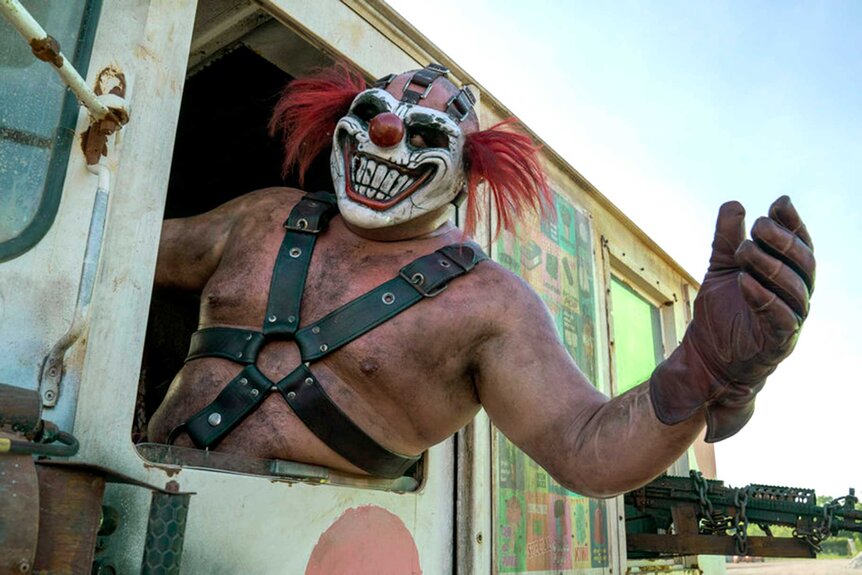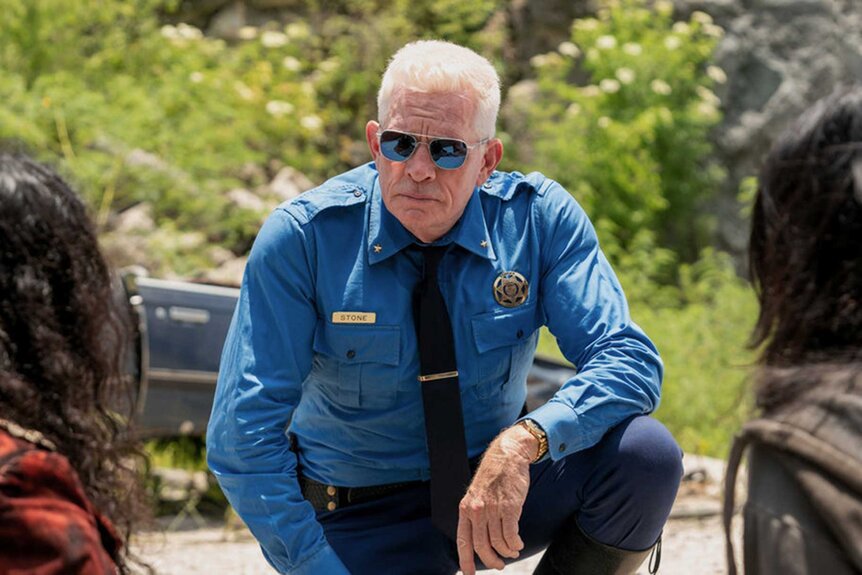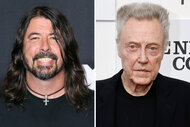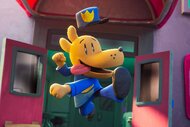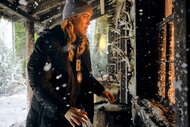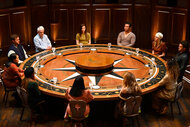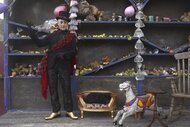Twisted Metal Sound Editor Had to "Completely Amplify" Original Video Game Effects for Peacock Series
"How do we pay homage to this huge franchise that has this cult-like following?" - James Parnell, Twisted Metal's Sound Editor.
James Parnell couldn't have been more perfect for the role of Supervising Sound Editor and Re-Recording Mixer on Peacock's small screen adaptation of Twisted Metal (all 10 episodes are now streaming!).
After all, the alum of heavy-hitting genre projects like Get Out, Happy Death Day, and Die Hart had once spent an entire summer playing Twisted Metal: Black in a friend's basement. "It was an easy answer," he told NBC Insider over a Zoom conversation ahead of the show's premiere.
RELATED: Twisted Metal Stars, Creators Break Down Wild Season Finale: "Fast & Furious On Steroids"
"It was just such a lovely experience working with the people at Sony and Peacock," Parnell added. "They championed all of the creative decisions and they were like, 'Go for it. Make it crazy. Make it insane.’ Because that's what the show is like: it's a heavy metal demolition derby, and they were up for all of it."
**SPOILER WARNING! The following contains spoilers for all of Peacock's Twisted Metal!**
Revisiting the Original Twisted Metal Sound Effects
The first order of business, Parnell explained, was to try and track down the "original assets" featured in the PlayStation video games upon which the series is based.
"The number one thing that lends authenticity to a show like this, especially when it comes to sound, is: ‘How do we pay homage to this huge franchise that has this cult-like following? How do we translate that to the screen?’"
Sony was, of course, more than happy to oblige, though the compressed nature of those files the company provided were non-conducive for use in a live-action setting.
RELATED: Anthony Mackie Wants a Rematch With Samoa Joe After His Twisted Metal Smackdown
"Video games are so immersive from a gameplay perspective, that you just buy them and sink into them," Parnell said. "The engines sounded great in the gameplay, but we had to kind of use them as a template and build on them. We needed to listen to the sound of Sweet Tooth’s truck and then completely amplify that and put it on steroids."
That ethos applied to every souped-up vehicle (nearly all of them recognizable iconic options from the source material) featured throughout the first 10 episodes. "A lot a lot of love was put into the vehicle builds and the weapon builds, sonically."
John Doe's Evelyn
Parnell used a Subaru WRX as the base sound for Evelyn, the beloved car of milkman John Doe (Anthony Mackie), but went even further by emphasizing how much "love and care" the lead protagonist has put into his trusty mode of transport over the years. In addition to the WRX, Evelyn also contains elements of "a Toyota 4-cylinder turbo racing rally car."
"Because this is his baby," he continued. "So we developed the sound of a turbo boost that you would have heard through the [mall chase in Episode 1]. Every time he hits the gas, you hear this kind of NOS-like exhaust kick in. We wanted to make it sound slick and polished."
The suggestion of a "gnarly and badass" turbo boost came at the behest of showrunner and executive producer Michael Jonathan Smith (lovingly referred to by the cast and crew as "MJ," he previously worked as a writer and producer on Netflix's Cobra Kai), who was "always pushing" the sound team to sweeten the final mix with little bits of "ear candy."
RELATED: Twisted Metal Stars Sound Off: "There’s So Much Cool Sh**" in Wild New Peacock Series
"He really knows what sound can bring to the table in terms of storytelling," Parnell said, noting that the showrunner suggested giving John's second car, Roadkill (a weaponized Camaro), "a little carbureted engine fan when it fires up" in the big finale.
This process of building badass automobiles required a precise and Frankenstein-y mashup of various effects culled from different libraries.
"Everyone who might just watch the show from a fan perspective, it's like, ‘Oh, it's the sound of the car that we're watching on set.’ But it's really a combination. If you look at the ProTools session, it's got seven or eight layers for each vehicle at any given time, sometimes as wide as 10 layers — especially when we shift from exterior to interior."
Sweet Tooth's Ice Cream Truck
According to Parnell, MJ wanted the clown's ride of choice to sound like "a combination of an old military truck and a tank recording and a legitimate ice cream truck."
"Heavy, oily, greasy, the machetes swinging around in the back," the sound editor elaborated. "Everything in his truck [he's] built with chains and scraps that he’s found from [other] cars. [We asked ourselves] 'How do we dirty up the engine? ... How do we make Sweet Tooth’s weapons sonically recognizable before we even hear him?' Same thing with his car. They hear Sweet Tooth before they see him."
Ironically, the on-set audio captured from the truck turned out to be "the cleanest" of the bunch (not that it mattered much one way or the other since Samoa Joe's dialogue was always going to be replaced in post). "I would have assumed that Sweet Tooth's ice cream truck ... would have been just this really janky, rattly [sound and] it would have been impossible to clean up if we had to use Samoa’s voice," Parnell confessed. "But actually, that was the cleanest."
RELATED: Twisted Metal Star Samoa Joe Confirms It Gets Really Hot Under That Sweet Tooth Mask
The car that made the most racket on set was Evelyn, "and it was because they wanted the car to sound pretty badass on set," the sound editor added. "What you're hearing onscreen isn't far off what that car would actually sound like if you pushed it to those extremes in a real-life scenario."
As such, there was a modicum of ADR required for John and Quiet (Stephanie Beatriz), though if Parnell did his job right, you'd never be able to tell the difference. "We did a ton of work on cleaning up the dialogue and preserving as much of the original production sound as possible," he said. "MJ, to his credit, was really good about being like, 'If an ADR line wasn’t working, lose it.’ It’s not worth taking an audience out of the story just to get a piece of story in or sweetening a performance.'"
Agent Stone's Outlaw
The police SUV driven by the season's main antagonist — highwayman Agent Stone (Thomas Haden Church) — went through several iterations, starting with a base layer of a GMC Suburban, which just didn't have the sinister "snarl" MJ was looking for.
"He was like, ‘It needs to sound meaner. Outlaw needs to sound like it's lead-plated. The engine is over-revving to drive the car.’" In the end, Parnell and his team went for a combination of "turbocharged" Land Rovers and Jeeps, as well as "some metal creaks" to reflect the protective metal cage around the vehicle.
RELATED: Anthony Mackie, Twisted Metal Creators Talk "Insane" Hopes For Season 2 of Peacock Series
"All of it came together to make a really gnarly version of Outlaw, which I think does a really good job of paying homage to [Agent Stone] in the video games."
The Sound of an Early Aughts Apocalypse in Twisted Metal
In the world of the show, civilization collapsed in 2002, meaning pocket technology peaked with the primitive (at least by today's smart phone standards) Nokia Fidos and T-Mobile Sidekicks.
To truly capture the sound of the early aughts, Parnell bought up old cell phones and similarly outdated tech from thrift stores, while also relying on libraries chock full of "original 8-bit cell phone rings." Limiting himself to the sonic world of the new millennium applied to the cars as well.
"There’s a fantastical element of it, too, because we're obviously souping up John's car, but we're trying to keep it period specific," he revealed. "I think just generally speaking ... anything we could do to keep us grounded in that 2002-2003 world is what we strived for."
MJ in particular regularly pushed the idea of a stagnated world where pretty much everything is falling apart 20 years after technology and the internet went bust in a Y2K-like catastrophe. "He was like, ‘I want to make it feel like the world just got completely decimated. All the computers going down, everything went to chaos. Things are older, groaning, creaky.'"
A perfect example of that philosophy can be found in the Lost Vegas casino occupied by Sweet Tooth in Episode 2. Parnell credits sound designer Eric Gilliam with building out the sonic landscape of the location with familiar, albeit failing, sounds we associate with Sin City gambling establishments.
"[He took] all those old ‘You win!’ ‘Winner! Winner!’ [recordings] and distorted them, pitched them down. Little things like that made the casino sound like it was just running on enough power, that the lights were just flickering enough ... Anything we could do to make this world sound like it had just survived being completely torn apart."
The same goes for Agent Stone's Hoover Dam base of operations. "You’re hearing the building," Parnell concludes. "We have these things called metal wronks and they’re groaning and creaking and you hear air pressure coming from pipes. Little things like that, I think, sonically immerse you in that world and you buy it."
All 10 episodes of Twisted Metal are now streaming on Peacock.
Want more original Peacock content? Be sure to check out Bel-Air, Killing It, A Friend of the Family, Poker Face, Joe vs. Carole, Mrs. Davis, MacGruber, and Based on a True Story.





